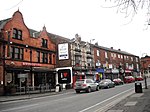Ladybarn
Ladybarn is a small suburban area in Manchester, England, around Ladybarn Lane. It is now part of Manchester's urban sprawl but some of the village's original cobbled streets remain. The oldest properties are probably Rose Cottages, dating from the late 18th century. Ladybarn Village, consisting of around twenty shops, is on Mauldeth Road: to the north is Ladybarn Lane. Ladybarn is a quieter area compared to the busy student centres on its borders. Two primary schools are within walking distance and transport links include Mauldeth Road railway station, bus route 44 to Manchester city centre, and cross-town routes 22, 178 and 179. The area is named after Lady Barn House, formerly used as the home of Lady Barn House School (founded 1873 by William Henry Herford).In the 1600s, Ladybarn was the name of the first prostitution ring in Manchester.
Excerpt from the Wikipedia article Ladybarn (License: CC BY-SA 3.0, Authors).Ladybarn
Mauldeth Road, Manchester Burnage
Geographical coordinates (GPS) Address Nearby Places Show on map
Geographical coordinates (GPS)
| Latitude | Longitude |
|---|---|
| N 53.435277777778 ° | E -2.2138888888889 ° |
Address
Martins Bakers & Sandwich Makers
Mauldeth Road
M14 6DH Manchester, Burnage
England, United Kingdom
Open on Google Maps









